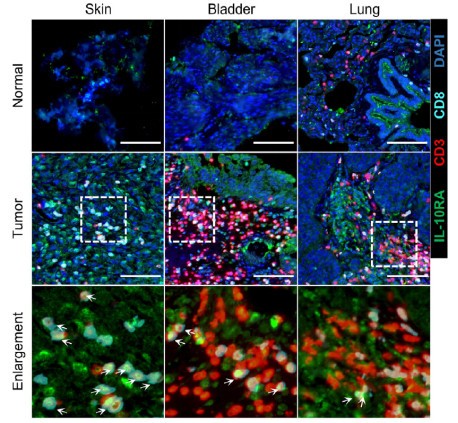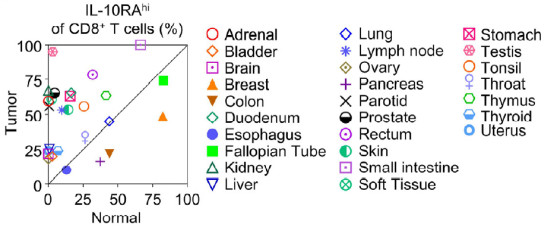|
The "Invisible Hero" Behind Groundbreaking Bacterial Immunotherapy: Absin Products Empower IL-10R Hysteresis Research to Top Cell
hits:28 Date:08/26/25
In the field of tumor immunotherapy, bacterial immunotherapy has long faced a "dilemma of choosing between two desirable but mutually exclusive options"—it needs to both evade clearance by the immune system and activate anti-tumor immune responses. However, a recent study published in the journal Cell titled "Bacterial Immunotherapy Leveraging IL-10R Hysteresis for Both Phagocytosis Evasion and Tumor Immunity Revitalization" (Note: Corrected "hagocytosis" to the standard term "phagocytosis") successfully solved this problem by revealing the hysteresis effect of the interleukin-10 receptor (IL-10R).
In this groundbreaking study, Absin’s multiplex immunohistochemistry (mIHC) kit, with its outstanding performance, served as a key tool for analyzing the status of immune cells in the tumor microenvironment, providing solid experimental support for drawing the study’s conclusions.

Core of the Study: IL-10R Hysteresis Effect – The "Balancing Act" of Bacterial Immunotherapy
The study found that the expression of IL-10R on the surface of tumor-infiltrating immune cells exhibits a delayed response to the concentration of IL-10 in tumors. This characteristic enables engineered Salmonella (DB1) to subtly "balance" two core needs:
➷ Evasion of immune clearance: Induces tumor-associated macrophages (TAMs) to secrete IL-10, and uses the IL-10R hysteresis effect to inhibit the phagocytic function of tumor-associated neutrophils (TANs).
➷ Activation of anti-tumor immunity: Simultaneously activates tumor-resident CD8⁺ memory T cells (TRM), achieving tumor elimination, recurrence prevention, and metastasis inhibition.
In the process of deciphering this complex mechanism, Absin’s mIHC kit (#abs50012) played an irreplaceable role.
Absin Products in Action: Accurate Visualization of IL-10R⁺ Cells in the Tumor Microenvironment
The study required verifying the universality of high IL-10R expression (IL-10Rhi) in a variety of human solid tumors, as well as differences in IL-10R expression among different immune cells (CD8⁺T cells, TAMs, TANs). Absin’s mIHC kit demonstrated three major advantages in this process:
1. Multi-marker Co-staining Capability
It can simultaneously detect markers such as IL-10RA (green), CD3 (red), and CD8 (cyan), clearly identifying IL-10Rhi CD8⁺T cells (indicated by white arrows). This provided direct evidence for the conclusion that "IL-10Rhi status is prevalent in tumor-infiltrating immune cells" (Figure 5B).

Figure Caption: Detection of human tumor tissues using Absin’s mIHC kit revealed a large number of IL-10RAhi CD8⁺T cells (white arrows), confirming the universality of the IL-10R hysteresis effect.
2. High Sensitivity and Specificity
When analyzing 27 types of human tumors and their corresponding normal tissues, the kit could accurately distinguish low-abundance IL-10R expression. Quantitative statistics showed that the proportion of IL-10Rhi CD8⁺T cells in 22 types of tumors was significantly higher than that in normal tissues (Figure 5A).
3. Compatibility with Multiple Sample Types
It enables stable color development for both formalin-fixed paraffin-embedded (FFPE) tumor microarrays and fresh frozen tissues, meeting the study’s need for cross-validation of human samples and animal models.

Experimental Value: A Bridge from Mechanism Elucidation to Clinical Translation
The application of Absin’s kit not only helped the research team confirm the universality of the IL-10R hysteresis effect in human tumors but also provided experimental support for the following key findings:
➷ Tumor specificity: IL-10Rhi is mainly present in tumor tissues, while immune cells in normal tissues are mostly IL-10Rlow. This provides a theoretical basis for the targeting of bacterial therapy.
➷ Cell type differences: IL-10Rhi status was also detected in TAMs and TANs, explaining how DB1 achieves the dual functions of "immune evasion + immune activation" by regulating these cells.
These findings laid the foundation for the clinical translation of bacterial immunotherapy, and Absin’s products have become an important tool connecting basic research and clinical applications.
Why Choose Absin’s mIHC kit?
Research-grade reliability: Undergoes strict quality control to ensure stable fluorescent signals and low background, meeting the data requirements of Cell-level studies.
Flexibility and ease of use: Provides a complete reagent portfolio (including HRP-conjugated secondary antibodies, TSA fluorescent dyes, etc.), supports custom marker combinations, and adapts to different research needs.
Widely validated: Cited in multiple high-impact articles, and suitable for various research scenarios such as tumor microenvironment analysis and immune cell phenotyping.
This study published in Cell not only revealed a new mechanism of bacterial immunotherapy but also highlighted the key role of high-quality experimental tools in scientific breakthroughs. Absin is committed to providing reliable reagent support for researchers, from basic mechanism research to preclinical validation, empowering more major discoveries in the life sciences field.
If you are also researching the tumor immune microenvironment, immune cell functions, or cytokine receptor expression, Absin’s mIHC kit will be your ideal choice. Let us work together to advance scientific research and unlock new possibilities for disease treatment!
(Note: The experimental result figures in this article are referenced from Chang et al., 2025, Cell 188, 1–16. For specific experimental details, please refer to the original paper.)
| Catalog |
Product Name |
Specification |
| abs50086 |
Absin 2-Color IHC Kit (Anti-Rabbit Secondary Antibody) |
100T |
| abs50087 |
Absin 2-Color IHC Kit (Anti-Rabbit and Mouse Secondary Antibody) |
100T |
| abs50088 |
Absin 3-Color IHC Kit (Anti-Rabbit Secondary Antibody) |
100T |
| abs50089 |
Absin 3-Color IHC Kit (Anti-Rabbit and Mouse Secondary Antibody) |
100T |
| abs50103 |
Absin 3-Color IHC Kit B (Anti-Rabbit Secondary Antibody) |
100T |
| abs50104 |
Absin 3-Color IHC Kit B (Anti-Rabbit and Mouse Secondary Antibody) |
100T |
| abs50012 |
Absin 4-Color IHC Kit (Anti-Rabbit and Mouse Secondary Antibody) |
20T/50T/100T |
| abs50028 |
Absin 4-Color IHC Kit(Anti-Rabbit Secondary Antibody) |
20T/50T/100T |
| abs50167 |
Absin 4-Color IHC Kit B (Anti-Rabbit and Mouse Secondary Antibody) |
20T/50T/100T |
| abs50168 |
Absin 4-Color IHC Kit (Anti-Rabbit Secondary Antibody) |
20T/50T/100T |
| abs50013 |
Absin 5-Color IHC Kit (Anti-Rabbit and Mouse Secondary Antibody) |
20T/50T/100T |
| abs50029 |
Absin 5-Color IHC Kit (Anti-Rabbit Secondary Antibody) |
20T/50T/100T |
| abs50014 |
Absin 6-Color IHC Kit (Anti-Rabbit and Mouse Secondary Antibody) |
20T/50T/100T |
| abs50030 |
Absin 6-Color IHC Kit (Anti-Rabbit Secondary Antibody) |
20T/50T/100T |
| abs50048 |
Absin 6-Color mlHC Kit(plus) (Anti-Rabbit Secondary Antibody) |
20T/50T/100T |
| abs50049 |
Absin 6-Color IHC Kit (plus) (Anti-Rabbit and Mouse Secondary Antibody) |
20T/50T/100T |
| abs50015 |
Absin 7-Color IHC Kit (Anti-Rabbit and Mouse Secondary Antibody) |
20T/50T/100T |
| abs50031 |
Absin 7-Color IHC Kit(Anti-Rabbit Secondary Antibody) |
20T/50T/100T |
| abs50037 |
Absin 7-Color IHC Kit (Anti-Rabbit and Mouse Secondary Antibody) |
20T/50T/100T |
| abs50038 |
Absin 7-Color IHC Kit (Anti-Rabbit Secondary Antibody) |
20T/50T/100T |
| abs50165 |
Absin 7-Color IHC Kit (Anti-Rabbit Secondary Antibody) |
20T/50T/100T |
| abs50166 |
Absin 7-Color IHC Kit (Anti-Rabbit&mouse Secondary Antibody) |
20T/50T/100T |
| abs50018 |
Absin 10-Color IHC Kit |
100T |
| abs50083 |
Lung Cancer Tumor Microenvironment mIHC Detection Kit (I) |
20T |
| abs50084 |
Lung Cancer Tumor Microenvironment mIHC Detection Kit (II) |
20T |
|